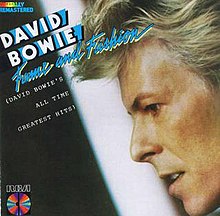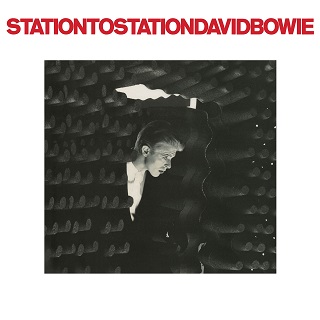
Station to Station is the tenth studio album by the English musician David Bowie, released on 23 January 1976 through RCA Records. Regarded as one of his most significant works, the album was the vehicle for Bowie's performance persona the Thin White Duke. Co-produced by Bowie and Harry Maslin, Station to Station was mainly recorded at Cherokee Studios in Los Angeles, California, in late 1975, after Bowie completed shooting the film The Man Who Fell to Earth; the cover art featured a still from the film. During the sessions, Bowie was dependent on drugs, especially cocaine, and later said that he recalled almost nothing of the production.

"Heroes" is the 12th studio album by the English musician David Bowie, released on 14 October 1977 through RCA Records. Recorded in collaboration with the musician Brian Eno and the producer Tony Visconti, it was the second release of his Berlin Trilogy, following Low, released in January the same year, and the only one wholly recorded in Berlin. Sessions took place in mid-1977 after Bowie completed work on Iggy Pop's second solo album Lust for Life. Much of the same personnel from Low returned for "Heroes", augmented by the King Crimson guitarist Robert Fripp.

Lodger is the 13th studio album by the English musician David Bowie, released on 25 May 1979 through RCA Records. Recorded in collaboration with the musician Brian Eno and the producer Tony Visconti, it was the final release of his Berlin Trilogy, following Low and "Heroes". Sessions took place in Switzerland in September 1978 during a break in the Isolar II world tour, and in New York City in March 1979 at the tour's end. Most of the same personnel from prior releases returned, and the future King Crimson guitarist Adrian Belew joined from the tour. The sessions saw the use of techniques inspired by Eno's Oblique Strategies cards, such as having the musicians swap instruments and play old songs backwards.
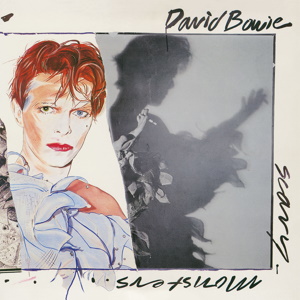
Scary Monsters (and Super Creeps), also known simply as Scary Monsters, is the 14th studio album by the English musician David Bowie, released on 12 September 1980 through RCA Records. His first album following the Berlin Trilogy (Low, "Heroes" and Lodger), Scary Monsters was Bowie's attempt to create a more commercial record after the trilogy proved successful artistically but less so commercially.
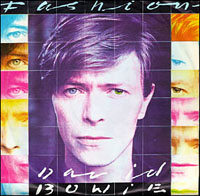
"Fashion" is a song by the English musician David Bowie from his 14th studio album Scary Monsters (1980). Co-produced by Bowie and Tony Visconti and recorded from February to April 1980 at New York and London, it was the last song completed for the album. Originating as a reggae parody titled "Jamaica", "Fashion" is a post-punk, dance and funk track structurally similar to Bowie's "Golden Years". King Crimson guitarist Robert Fripp contributed lead guitar.
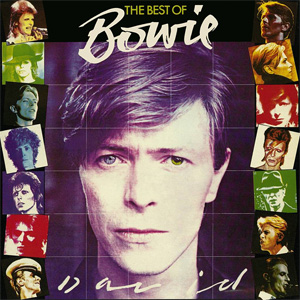
The Best of Bowie is a compilation album by English singer-songwriter David Bowie, released in 1980 by K-tel. The cover was based on the 12-inch single sleeve design of Bowie's "Fashion". It made No. 3 in the UK Albums Chart.

Carlos Alomar is a Puerto Rican guitarist. He is best known for his work with David Bowie from the mid-1970s to the early 2000s, having played on more Bowie albums than any other musician.

Changesonebowie is a compilation album by English musician David Bowie, issued through RCA Records in 1976. It collected songs from the 1969–1976 period, including the first LP appearance of "John, I'm Only Dancing". A "sax version" of this song, cut during the Aladdin Sane sessions in 1973, appeared on the first 1000 copies of the UK pressing. Later pressings of Changesonebowie featured the original version of the single that had been recorded and released in 1972. All US pressings of the LP contain this original version as well.

Stage is the second live album by the English musician David Bowie, recorded on the Isolar II Tour, and released through RCA Records in 1978. Stage has been reissued numerous times, each with expanded track listings.

"Scary Monsters (and Super Creeps)" is a song by the English singer-songwriter David Bowie, released as the title track of his 1980 album Scary Monsters (and Super Creeps). It was also issued as the third single from that album in January 1981. Coming as it did in the wake of two earlier singles from Scary Monsters, "Ashes to Ashes" in August 1980 and "Fashion" in October the same year, NME critics Roy Carr and Charles Shaar Murray labelled its release another instance "in the fine old tradition of milking albums for as much as they could possibly be worth". The song was subsequently performed on a number of Bowie tours.
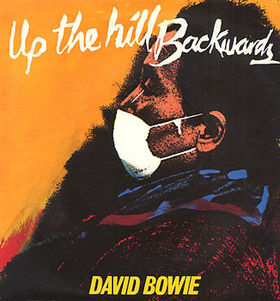
"Up the Hill Backwards" is a song by the English musician David Bowie, released on his 1980 album Scary Monsters . It was later issued by RCA Records as the fourth and final single from the album in March 1981. Originally written under the title "Cameras in Brooklyn", the song was recorded between February and April 1980 at the Power Station in New York City and Good Earth Studios in London. The recording features backing vocalists, guitar contributions from Robert Fripp and acoustic guitar played by co-producer Tony Visconti. Lyrically, the song concerns the struggles of facing a crisis, partially influenced by Bowie's divorce from his wife Angie. Musically, the song contains numerous time signature changes and a Bo Diddley-inspired beat.

"Stay" is a song by the English musician David Bowie, released on his 1976 album Station to Station. The song was recorded in late 1975 at Cherokee Studios in Los Angeles. Co-produced by Bowie and Harry Maslin, the recording featured guitarists Carlos Alomar and Earl Slick, bassist George Murray, drummer Dennis Davis, pianist Roy Bittan and Warren Peace on percussion. The track features prominent dual guitar work from Slick and Alomar, who mostly composed it in the studio. Based on the chord structure of "John, I'm Only Dancing (Again)", a funk reworking of "John, I'm Only Dancing" (1972), "Stay" emulates funk rock, soul and hard rock. The song's lyrics are abstract and relate to love.
"Teenage Wildlife" is a song written by David Bowie in 1980 for the album Scary Monsters . Running at almost seven minutes, the song was the longest track on Scary Monsters, and Bowie's longest composition since "Station to Station" (1976), although it was surpassed in length by later tracks such as 2003's "Bring Me the Disco King" and 2016's "Blackstar".

Rare is a compilation album by the English musician David Bowie, released by RCA Records in December 1982. The artist's relations with the company were at a low – Bowie had recorded his last music for RCA Records with the Baal EP, and had been annoyed by the release of a five-year-old duet with Bing Crosby as a single without his consultation. Bowie informed RCA he was unhappy with the Rare compilation, and would sign with EMI Records for his next album. All tracks on Rare were being issued for the first time on LP and cassette.

A Reality Tour is a DVD released in 2004 of David Bowie's performance at Point Theatre in Dublin, Ireland in 2003 during the A Reality Tour.

Golden Years is a 1983 compilation album by David Bowie issued by RCA Records.

Bowie – The Video Collection is a video album by David Bowie, released in 1993. It included most official music videos made by Bowie between 1972 and 1990.
The Outside Tour was a tour by the English rock musician David Bowie, opening in September 1995 and lasting over a year. The opening shows preceded the release of the 1. Outside album which it supported. The tour visited stops in North America and Europe.

The Earthling Tour was a concert tour by the English musician David Bowie, in promotion of his album Earthling, released in 1997, The tour started on 7 June 1997 at Flughafen Blankensee in Lübeck, Germany, continuing through Europe, North America before reaching a conclusion in Buenos Aires, Argentina on 7 November 1997.

"Ashes to Ashes" is a song by the English singer-songwriter David Bowie from his 14th studio album, Scary Monsters (1980). Co-produced by Bowie and Tony Visconti, it was recorded from February to April 1980 in New York and London and features guitar synthesiser played by Chuck Hammer. An art rock, art pop and new wave song led by a flanged piano riff, the lyrics act as a sequel to Bowie's 1969 hit "Space Oddity": the astronaut Major Tom has succumbed to drug addiction and floats isolated in space. Bowie partially based the lyrics on his own experiences with drug addiction throughout the 1970s.
